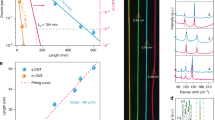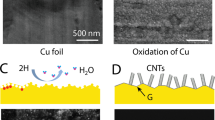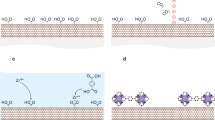Abstract
THE discovery1 and bulk synthesis2 of carbon nanotubes has stimulated great interest. It has been suggested that these structures may have useful electronic3–5 and mechanical6 properties, and these might be modified by introducing foreign materials into the nanotubes. But the tubes are invariably capped at the ends. Ajayan and lijima7 have succeeded in drawing molten material (lead or one of its compounds) into the tubes by heating them in the presence of lead and oxygen; less than 1% of the tubes in the sample studied could be filled in this way. Here we report that heating in carbon dioxide gas can result in the partial or complete destruction of the tube caps and stripping of the outer layers to produce thinner tubes. In some cases, we have thinned the extremity of tubes to a single layer. The opened tubes can be regarded as nanoscale test-tubes for adsorption of other molecules, and this controlled method of thinning may allow studies of the properties of single tubes.
This is a preview of subscription content, access via your institution
Access options
Subscribe to this journal
Receive 51 print issues and online access
$199.00 per year
only $3.90 per issue
Buy this article
- Purchase on Springer Link
- Instant access to full article PDF
Prices may be subject to local taxes which are calculated during checkout
Similar content being viewed by others
References
Iijima S. Nature 354, 56–58 (1991).
Ebbesen, T. W. & Ajayan, P. M. Nature 358, 220–221 (1992).
Saito, R., Fujita, M., Dresselhaus, G. & Dresselhaus, M. S. Appl. Phys. Lett. 60, 2204–2206 (1992).
Mintmire, J. W., Dunlap, B. I. & White, C. T. Phys. Rev. Lett. 68, 631–634 (1992).
Hamada, N., Sawada, S.-I. & Oshiyama, A. Phys. Rev. Lett. 68, 1579–1582 (1992).
Overney, G., Zhong, W. & Tománek, D. Z. Phys. D (in the press).
Ajayan, P. M. & Iijima, S. Nature 361, 333–334 (1993).
Kratschmer, W., Lamb, L. D., Fostiropolous, K. & Huffman, D. R. Nature 347, 354–358 (1990).
Harris, P. J. F., Green, M. L. H. & Tsang, S. C. Faraday Trans. (in the press).
Brunauer, S., Emmett, P. M. & Teller, E. J. Am. chem. Soc. 60, 309–311 (1938).
Iijima, S., Ichihashi, T. & Ando, Y. Nature 356, 776–778 (1992).
Iijima, S. Phil. Trans. R. Soc. A. (in the press).
Ugarte, D. Chem. Phys. Lett. 198, 596–602 (1992).
Dresselhaus, M. S. Nature 358, 195–196 (1992).
Rostrup-Nielsen, J. R. Catalytic Steam Reforming in Science and Technology (eds Anderson, J. R. & Boudart, M.) 2–117 (Springer, Berlin, 1984).
Author information
Authors and Affiliations
Rights and permissions
About this article
Cite this article
Tsang, S., Harris, P. & Green, M. Thinning and opening of carbon nanotubes by oxidation using carbon dioxide. Nature 362, 520–522 (1993). https://doi.org/10.1038/362520a0
Received:
Accepted:
Issue Date:
DOI: https://doi.org/10.1038/362520a0
This article is cited by
-
Enhanced thermal and structural properties of UHMWPE/CNT nanocomposite sheets prepared by using melt compounding technique
Polymer Bulletin (2023)
-
Oxidation-aided cap-removal of chemical vapor deposition-prepared single-wall carbon nanotubes
Adsorption (2023)
-
Molecular dynamics study of lithium intercalation into –OH functionalized carbon nanotube bundle
Scientific Reports (2022)
-
Effect of multi-walled carbon nanotubes on the damping property of cement mortar and mechanism analysis
Archives of Civil and Mechanical Engineering (2021)
-
Effect of in-situ growth and separate addition method in hydrothermal process on the structural and magnetic properties of CoNiFe2O4@functionalized CNTs nanocomposite
Applied Physics A (2021)
Comments
By submitting a comment you agree to abide by our Terms and Community Guidelines. If you find something abusive or that does not comply with our terms or guidelines please flag it as inappropriate.



